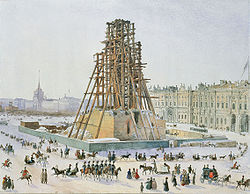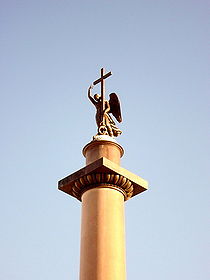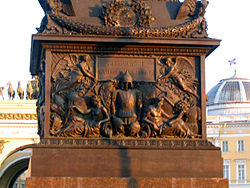- Alexander Column
-
The Alexander Column (Russian: Алекса́ндровская коло́нна, Aleksandrovskaya Kolonna) also known as Alexandrian Column (Russian: Александри́йская коло́нна, Aleksandriyskaya Kolonna), is the focal point of Palace Square in Saint Petersburg, Russia. The monument was erected after the Russian victory in the war with Napoleon's France. Named after Emperor Alexander I, who ruled Russia between 1801 and 1825, the column is an interesting piece of architecture and engineering.
Contents
Column
The Alexander Column was designed by the French-born architect Auguste de Montferrand, built between 1830 and 1834, and unveiled on 30 August 1834. The monument — the tallest of its kind in the world — is 47.5 m (155 ft 8 in) tall and is topped with a statue of an angel holding a cross. The statue of the angel was designed by the Russian sculptor Boris Orlovsky. The face of the angel bears great similarity to the face of Emperor Alexander I.
The column is a single piece of red granite, 25.45 m (83 ft 6 in) long and about 3.5 m (11 ft 5 in) in diameter. The granite monolith was obtained from Virolahti, Finland and in 1832 transported by sea to Saint Petersburg, on a barge specially designed for this purpose, where it underwent further working. Without the aid of modern cranes and engineering machines, the column, weighing 600 tonnes (661 tons), was erected by 3,000 men under the guidance of William Handyside in less than 2 hours. It is set so neatly that no attachment to the base is needed.
Pedestal
The pedestal of the Alexander Column is decorated with symbols of military glory, sculpted by Giovanni Battista Scotti.
On the side of the pedestal facing the Winter Palace is a bas-relief depicting winged figures holding up a plaque bearing the words "To Alexander I from a grateful Russia". The composition includes figures representing the Neman and Vistula rivers that were associated with the events of the Patriotic War. Flanking these figures are depictions of old Russian armour - the shield of Prince Oleg of Novgorod, the helmet of Alexander Nevsky, the breastplate of Emperor Alexander I, the chainmail of Yermak Timofeyevich and other pieces recalling heroes whose martial feats brought glory to Russia.
The other three sides are decorated with bas-reliefs featuring allegorical figures of Wisdom and Abundance, Justice and Mercy, Peace and Victory, the last holding a shield bearing the dates 1812, 1813 and 1814. These compositions are enhanced by depictions of Ancient Roman military symbols and Russian armour.
The sketches for the bas-reliefs were produced by Auguste de Montferrand. He coordinated the scale of their compositions with the monumental forms of the monument. The panels were designed to the planned size by the artist Giovanni Battista Scotti. The models were produced by the sculptors Piotr Svintsov and Ivan Lepee, the ornamental embellishments by sculptor Yevgeny Balin. The casting of the bronze was done at Charles Baird's works in Saint Petersburg.
Later years
In 1952, according to some recent reports, the authorities of the Soviet Union secretly planned to replace the statue of the angel with a statue of Joseph Stalin.[1] A historic iron fencing around the column was demolished during the Soviet period. The fencing was restored in 2002.
Further reading
- Ротач А. Л. Александровская колонна. Leningrad, 1966.
See also
- List of largest monoliths in the world
Monuments of Saint Petersburg Alexander Column • Bronze Horseman • Hero-City Obelisk • Column of Glory • Cruiser Aurora • Peter I near St. Michael's Castle • Church of the Savior on Blood • Alexander Pushkin in Arts Square • Nikolai Gogol in Konushennaya Street • Chesme Column • Kagul Obelisk • Monument to Nicholas I • Mother Motherland • Moscow Triumphal Gate • Narva Triumphal Gate Pedestrian zones of Saint Petersburg by creation year Pedestrian
zones1996Malaya Konushennaya Street19981999Planernaya Street (Avenue to Liquidators Chernobyl Accidents)20002001Gospitalniy pereulok • 6-7 Liniya of Vasilievsky Island • Finskiy pereulok • Bulvar Novatorov • On ninth of January Prospekt • Tankistov Street • Volodarskogo Street • Quarter 5 (Rzhevka) • Quarter 11 • Svoboda Square • Rubakina Street • Alexandrovskaya Street • near Zvyozdnaya • near Lomonosovskaya, Matushenko Street • Nizhnaya Doroga • near Staraya Derevnya • Akademitheskiy Prodpekt • Arts Square2002near Shuvalovo • Quarter 18 - 18А • Burenin Street • Blagodatnaya Street (first stage) • Kommunarov Street • near Gorkovskaya, Alexander Park • Sadovaya Street, Tsarskoye Selo • Turku Street • Quarter 24 • Konushenniy Pereulok • Kuznechniy Pereulok • Palace Square2003Andreevskie Dvoriki: 27, 6 Liniya of Vasilievsky Island · 32, 7 Liniya of Vasilievsky Island • near Udelnaya • Rizhskaya Street • Quarter 5 (South-West) • Blagodatnaya Street (second stage) • Shlisselburgskiy Prospekt • near Petrogradskaya, Bezimyanniy Pereulok • Klenovaya Alleya • Millionnaya Street • Griboyedov Canal Quay • Bolshaya Konushennaya Street • Solyanoy Pereulok2009Blagoeva streetMemorials Alexander Column • Bronze Horseman • Hero-City Obelisk • Column of Glory • Cruiser Aurora • Peter I near St. Michael's Castle • Church of the Savior on Blood • Alexander Pushkin in Arts Square • Nikolai Gogol in Konushennaya Street • Chesme Column • Kagul Obelisk • Monument to Nicholas I • Mother Motherland • Moscow Triumphal Gate • Narva Triumphal Gate • Vasily Korchmin • Liquidators Chernobyl Accidens • Genio loci • Barometer clock • Saint Petersburgs policeman • Sphere fountain • Photographer • ReproductCoordinates: 59°56′21″N 30°18′57″E / 59.93917°N 30.31583°E
Categories:- Pedestrian zones of Saint Petersburg
- Monumental columns in Russia
- Monuments in Saint Petersburg
- Buildings and structures completed in 1834
- Palace Square
- Auguste de Montferrand buildings and structures
Wikimedia Foundation. 2010.




